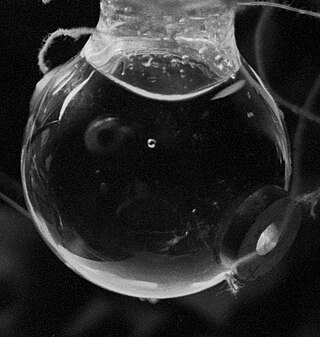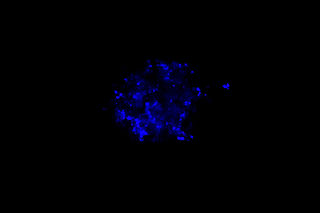Related Research Articles

The Auger effect or Auger−Meitner effect is a physical phenomenon in which the filling of an inner-shell vacancy of an atom is accompanied by the emission of an electron from the same atom. When a core electron is removed, leaving a vacancy, an electron from a higher energy level may fall into the vacancy, resulting in a release of energy. Although most often this energy is released in the form of an emitted photon, the energy can also be transferred to another electron, which is ejected from the atom; this second ejected electron is called an Auger electron.

In chemistry and physics, metastability denotes an intermediate energetic state within a dynamical system other than the system's state of least energy. A ball resting in a hollow on a slope is a simple example of metastability. If the ball is only slightly pushed, it will settle back into its hollow, but a stronger push may start the ball rolling down the slope. Bowling pins show similar metastability by either merely wobbling for a moment or tipping over completely. A common example of metastability in science is isomerisation. Higher energy isomers are long lived because they are prevented from rearranging to their preferred ground state by barriers in the potential energy.
In physics, attenuation is the gradual loss of flux intensity through a medium. For instance, dark glasses attenuate sunlight, lead attenuates X-rays, and water and air attenuate both light and sound at variable attenuation rates.

Sonoluminescence is the emission of light from imploding bubbles in a liquid when excited by sound.

Luminescence is the "spontaneous emission of radiation from an electronically excited species not in thermal equilibrium with its environment", according to the IUPAC definition. A luminescent object is emitting "cold light", in contrast to "incandescence", where an object only emits light after heating. Generally, the emission of light is due to the movement of electrons between different energy levels within an atom after excitation by external factors. However, the exact mechanism of light emission in "vibrationally excited species" is unknown, as seen in sonoluminescence.

Triboluminescence is a phenomenon in which light is generated when a material is mechanically pulled apart, ripped, scratched, crushed, or rubbed. The phenomenon is not fully understood, but appears to be caused by the separation and reunification of static electrical charges. The term comes from the Greek τρίβειν and the Latin lumen (light). Triboluminescence can be observed when breaking sugar crystals and peeling adhesive tapes.

In chemistry, an enantiomer – also called optical isomer, antipode, or optical antipode – is one of two stereoisomers that are non-superposable onto their own mirror image. Enantiomers are much like one's right and left hands, when looking at the same face, they cannot be superposed onto each other. No amount of reorientation in three spatial dimensions will allow the four unique groups on the chiral carbon to line up exactly. The number of stereoisomers a molecule has can be determined by the number of chiral carbons it has. Stereoisomers include both enantiomers and diastereomers.
In chemistry, chromism is a process that induces a change, often reversible, in the colors of compounds. In most cases, chromism is based on a change in the electron states of molecules, especially the π- or d-electron state, so this phenomenon is induced by various external stimuli which can alter the electron density of substances. It is known that there are many natural compounds that have chromism, and many artificial compounds with specific chromism have been synthesized to date. It is usually synonymous with chromotropism, the (reversible) change in color of a substance due to the physical and chemical properties of its ambient surrounding medium, such as temperature and pressure, light, solvent, and presence of ions and electrons.

An ion laser is a gas laser that uses an ionized gas as its lasing medium. Like other gas lasers, ion lasers feature a sealed cavity containing the laser medium and mirrors forming a Fabry–Pérot resonator. Unlike helium–neon lasers, the energy level transitions that contribute to laser action come from ions. Because of the large amount of energy required to excite the ionic transitions used in ion lasers, the required current is much greater, and as a result almost all except for the smallest ion lasers are water-cooled. A small air-cooled ion laser might produce, for example, 130 milliwatts of output light with a tube current of about 10 amperes and a voltage of 105 volts. Since one ampere times one volt is one watt, this is an electrical power input of about one kilowatt. Subtracting the (desirable) light output of 130 mW from power input, this leaves the large amount of waste heat of nearly one kW. This has to be dissipated by the cooling system. In other words, the power efficiency is very low.

Hydrogen (1H) has three naturally occurring isotopes, sometimes denoted 1
H
, 2
H
, and 3
H
. 1
H
and 2
H
are stable, while 3
H
has a half-life of 12.32(2) years. Heavier isotopes also exist, all of which are synthetic and have a half-life of less than one zeptosecond (10−21 s). Of these, 5
H
is the least stable, while 7
H
is the most.

Strontium aluminate is an aluminate compound with the chemical formula SrAl2O4. It is a pale yellow, monoclinic crystalline powder that is odourless and non-flammable. When activated with a suitable dopant, it acts as a photoluminescent phosphor with long persistence of phosphorescence.

Kasha's rule is a principle in the photochemistry of electronically excited molecules. The rule states that photon emission occurs in appreciable yield only from the lowest excited state of a given multiplicity. It is named after American spectroscopist Michael Kasha, who proposed it in 1950.
The linear attenuation coefficient, attenuation coefficient, or narrow-beam attenuation coefficient characterizes how easily a volume of material can be penetrated by a beam of light, sound, particles, or other energy or matter. A coefficient value that is large represents a beam becoming 'attenuated' as it passes through a given medium, while a small value represents that the medium had little effect on loss. The SI unit of attenuation coefficient is the reciprocal metre (m−1). Extinction coefficient is another term for this quantity, often used in meteorology and climatology. Most commonly, the quantity measures the exponential decay of intensity, that is, the value of downward e-folding distance of the original intensity as the energy of the intensity passes through a unit thickness of material, so that an attenuation coefficient of 1 m−1 means that after passing through 1 metre, the radiation will be reduced by a factor of e, and for material with a coefficient of 2 m−1, it will be reduced twice by e, or e2. Other measures may use a different factor than e, such as the decadic attenuation coefficient below. The broad-beam attenuation coefficient counts forward-scattered radiation as transmitted rather than attenuated, and is more applicable to radiation shielding.

In analytical and organic chemistry, elution is the process of extracting one material from another by washing with a solvent; as in washing of loaded ion-exchange resins to remove captured ions.
Commonly referred as phosphorescence, persistent luminescence is the emission of light by a phosphorescent material after an excitation by ultraviolet or visible light. Such materials would "glow in the dark".

The Uncompahgre Ute or ꞌAkaꞌ-páa-gharʉrʉ Núuchi is a band of the Ute, a Native American tribe located in the US states of Colorado and Utah. In the Ute language, uncompahgre means "rocks that make water red." The band was formerly called the Tabeguache.
Piezoluminescence is a form of luminescence created by pressure upon certain solids. This phenomenon is characterized by recombination processes involving electrons, holes and impurity ion centres. Some piezoelectric crystals give off a certain amount of piezoluminescence when under pressure. Irradiated salts, such as NaCl, KCl, KBr and polycrystalline chips of LiF (TLD-100), have been found to exhibit piezoluminescent properties. It has also been discovered that ferroelectric polymers exhibit piezoluminescence upon the application of stress.
Chain scission is a term used in polymer chemistry describing the degradation of a polymer main chain. It is often caused by thermal stress (heat) or ionizing radiation, often involving oxygen. During chain cleavage, the polymer chain is broken at a random point in the backbone to form two - mostly still highly molecular - fragments.
Ultrasound-switchable fluorescence (USF) imaging is a deep optics imaging technique. In last few decades, fluorescence microscopy has been highly developed to image biological samples and live tissues. However, due to light scattering, fluorescence microscopy is limited to shallow tissues. Since fluorescence is characterized by high contrast, high sensitivity, and low cost which is crucial to investigate deep tissue information, developing fluorescence imaging technique with high depth-to-resolution ratio would be promising.. Recently, ultrasound-switchable fluorescence imaging has been developed to achieve high signal-to-noise ratio (SNR) and high spatial resolution imaging without sacrificing image depth.